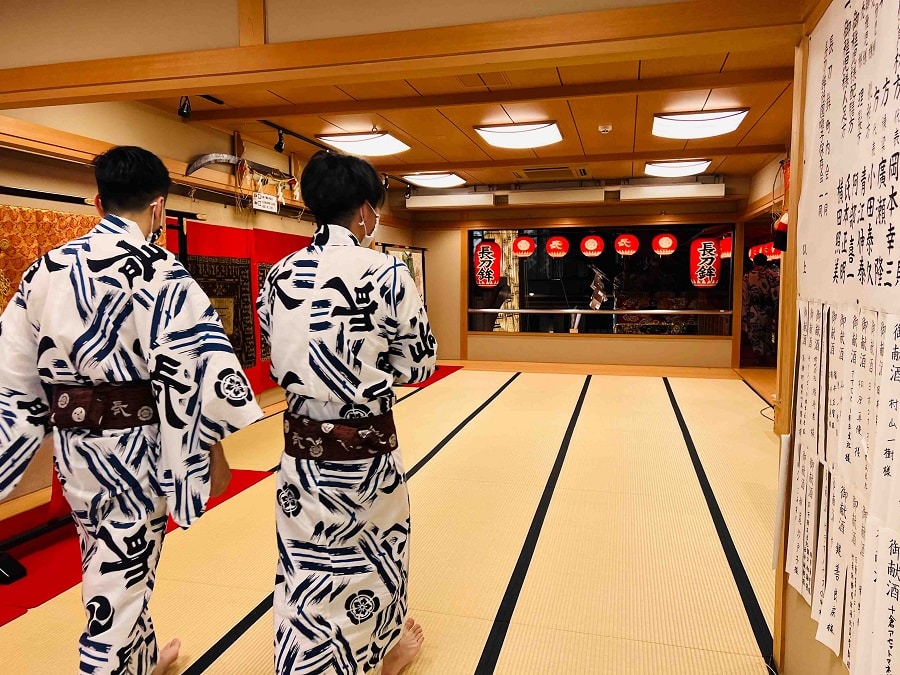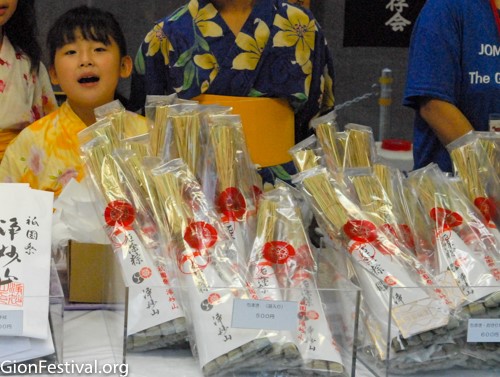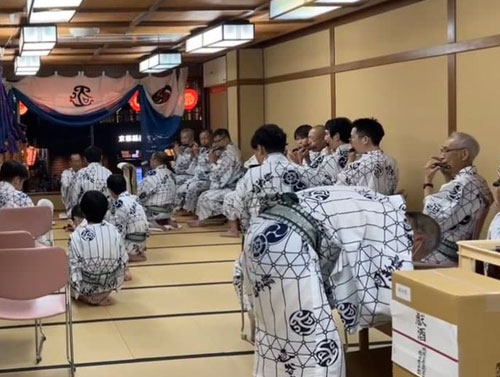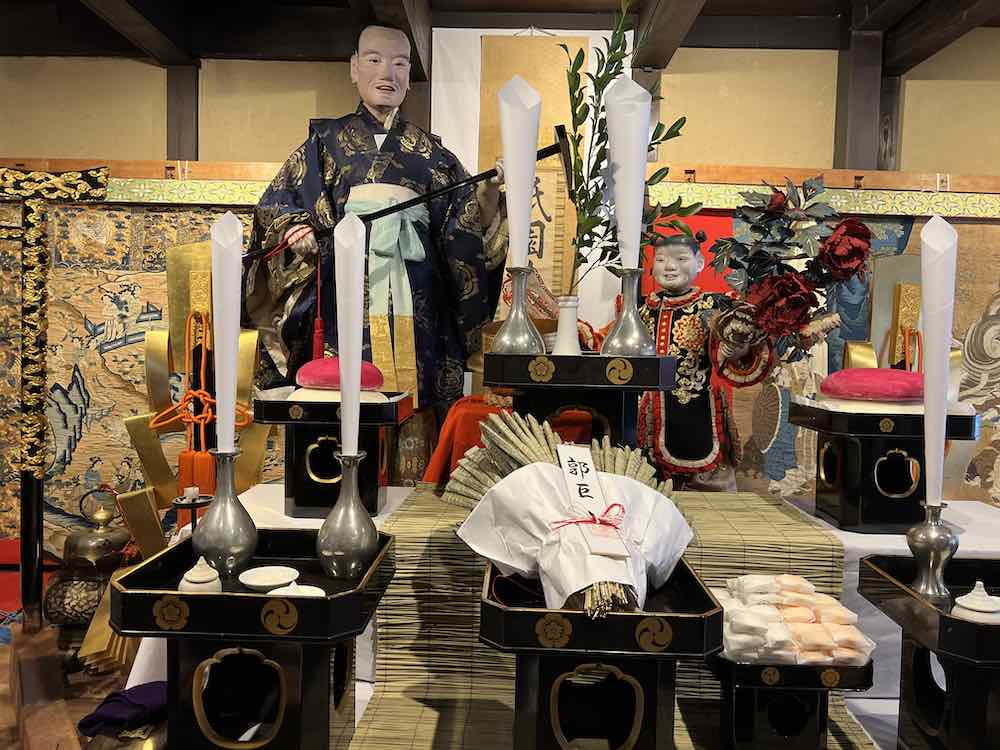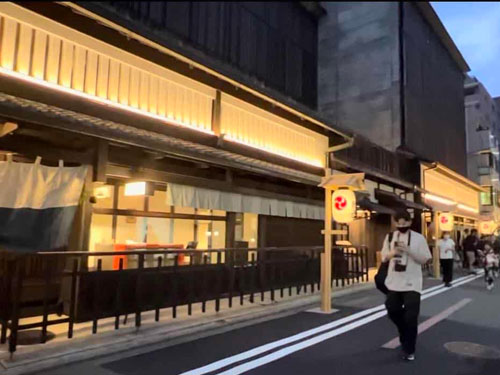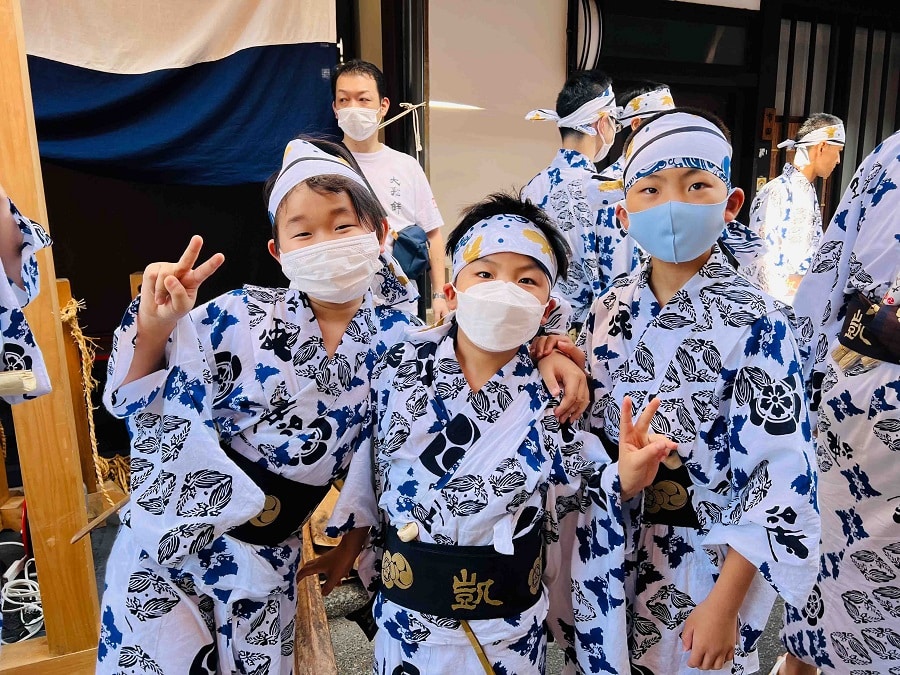Gion Festival 2022 was a milestone in its history: it marked the first time the festival resumed after being scaled back due to a pandemic. Remember, averting epidemics was the festival’s original purpose. So Gion Matsuri 2022 marked a kind of rebirth in its history.
Let’s recall that in the Gion Festival 2020, the famous yamaboko floats weren’t built. In the Gion Festival 2021, the yamaboko were built, but didn’t take part in the famous Gion Matsuri yamaboko processions. Similarly, in those years there were no processions of the portable mikoshi shrines. These are normally carried from Yasaka Shrine to the downtown otabisho “traveling place” and back again, in the spiritual heart of the festival’s extensive amalgamation of rituals. All these did take place in Gion Festival 2022, to the delight and relief of the festival community and general public.
However, covid was still a major concern in Japan in July 2022. One result was that non-residents were only permitted into the country with a business visa, which were challenging to obtain. Tourists were still not being allowed into the country. But since non-Japanese tourists at the Gion Matsuri are relatively small in number, this was not considered a major issue. Personally, it took a lot of resources for me to make it to Kyoto for Gion Festival 2022. And it was only possible thanks to some very generous support from some kind Japanese friends.
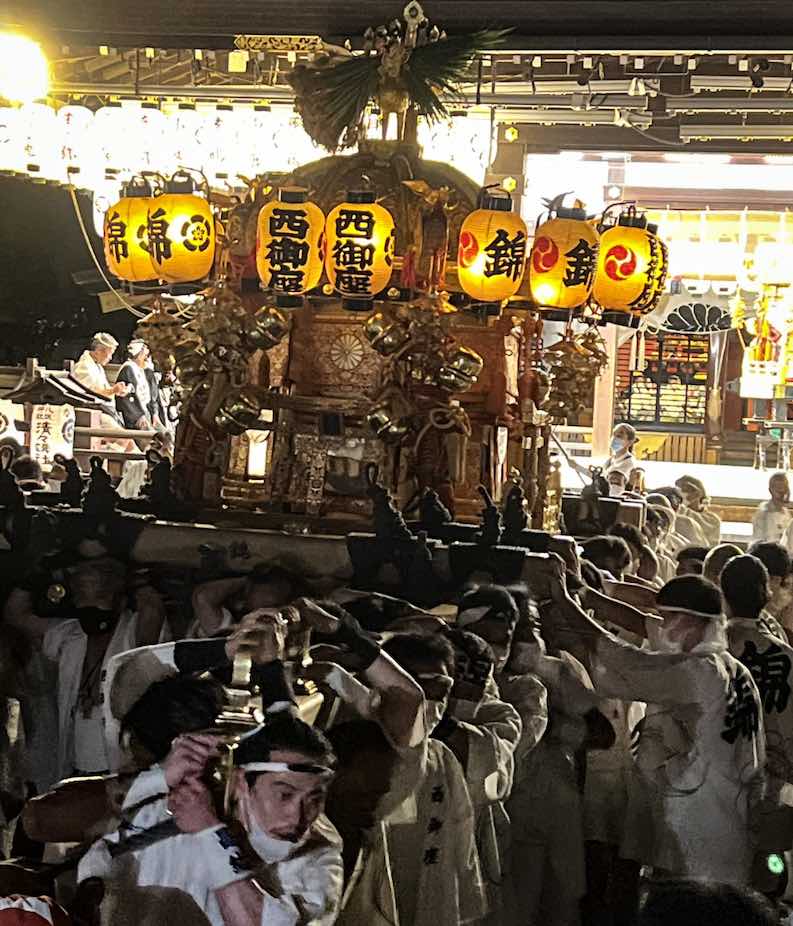
Gion Festival Amidst Covid
Different from usual, most of the large floats were not open to the public in the first half of the festival, known as the Saki Matsuri.This year, only Naginata Boko members could spend time in its kaisho meeting place and board the float, with not even their family members allowed. Tsuki Boko was similarly strict, and Iwato Yama did not allow the public to board its float either. Every year Naginata Boko sells tens of thousands of chimaki, the Gion Festival’s famous distinctive amulets; but this year its sales were strictly online only, with sales in advance.
Within the small float communities themselves, precautions started out strict. Festival participants were required to have the latest vaccines and take covid tests before the festival began. Additional measures were taken: Kanko Boko ohayashi musicians, for example, took and logged their temperatures before beginning to play music together. Different from some of the other large floats, the public was allowed in to view Kanko Boko treasures and board the float for the usual small fee.
Portable Shrines and Geisha
The three portable mikoshi floats enshrining the three Gion Matsuri deities usually travel very circumlocutory routes from Yasaka Shrine to the otabisho in central Kyoto on the evening of July 17, and back again on July 24. This is so the deities can bless all the neighborhoods and residents. As a covid precaution, for Gion Matsuri 2022 the mikoshi were carried a straight (and shorter) route down Shijo-dori street each on both evenings. However, the density of the mask-wearing crowds once more made social distancing impossible.
The lovely Hanagasa Junko procession on July 24 is a lesser-known part of the Gion Matsuri. But it’s well loved thanks to participation by geiko-san (Kyoto’s geisha and apprenticing maiko), children, and traditional dancers and musicians. For Gion Festival 2022, unfortunately the Hanagasa Junko did not take place.
For the yamaboko floats, how many and what kind of covid precautions each took was up to each float’s chonai community. Though they paid close attention to recommendations from Japanese health officials and the local and national governments, floats’ semiautonomy is a longstanding tradition and unique feature of this festival. In other words, there is no central organizing body.
However, throughout Japan mask-wearing is a standard smart precaution as well as a social courtesy for even the common cold. With covid, that means that at the Gion Festival 2022 everyone was wearing masks 98% of the time. Some exceptions may have been made for photos with close friends, if the environment made the covid risk low. Gion Festival flute players had special masks that allowed them to play their instrument.
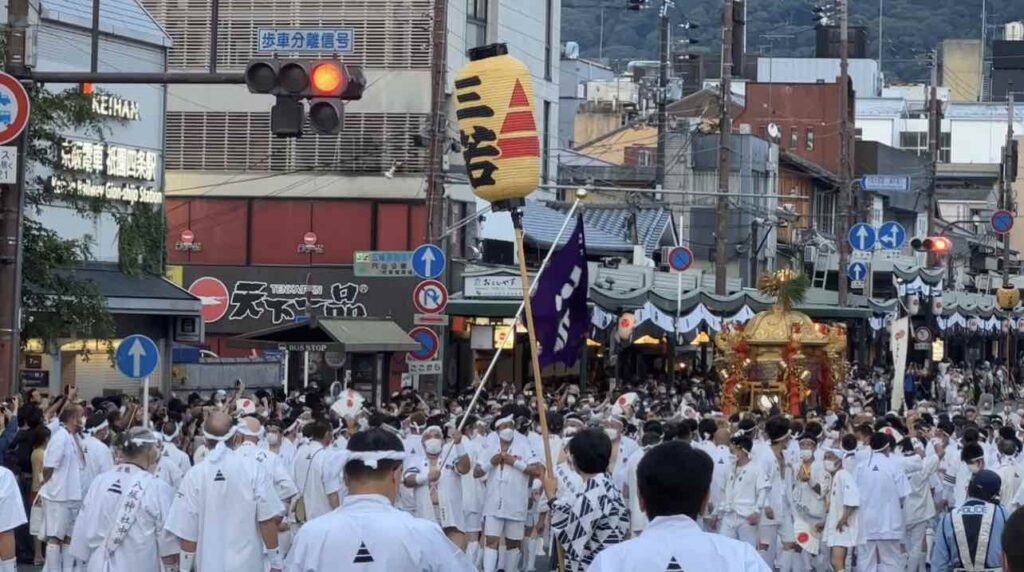
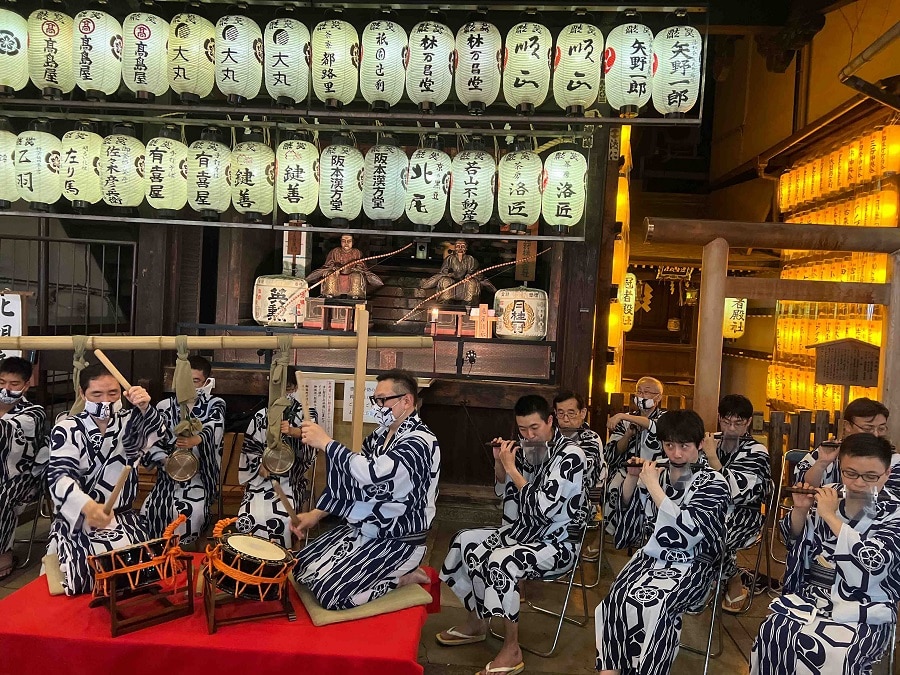
Taka Yama Debut Celebrated!
The indisputable highlight of Gion Matsuri 2022 was the reintroduction of the Taka Yama float into the Gion Festival’s Ato Matsuri (“Later Festival”), July 18-24. Taka Yama last took part in the Gion Matsuri in the year 1826. Remarkably, the chonai neighborhood’s dedicated efforts combined with the public’s enthusiastic support resulted in Taka Yama rejoining three years ahead of schedule!
Left image: The newly re-introduced Taka Yama, the star of the 2023 Gion Festival.
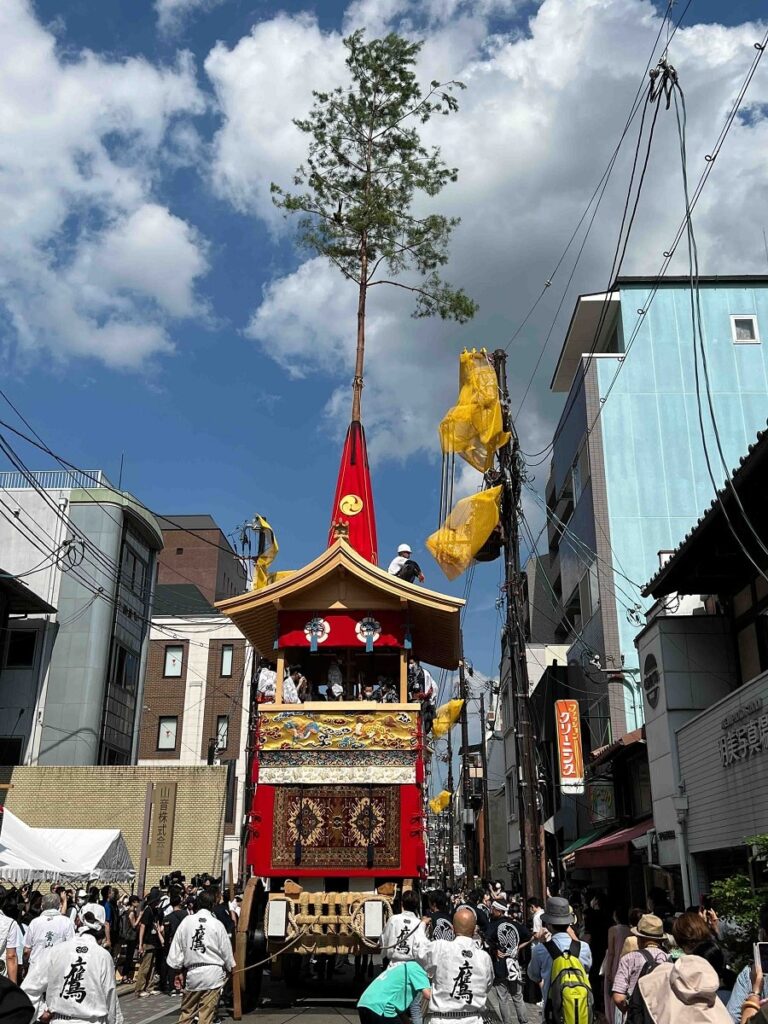
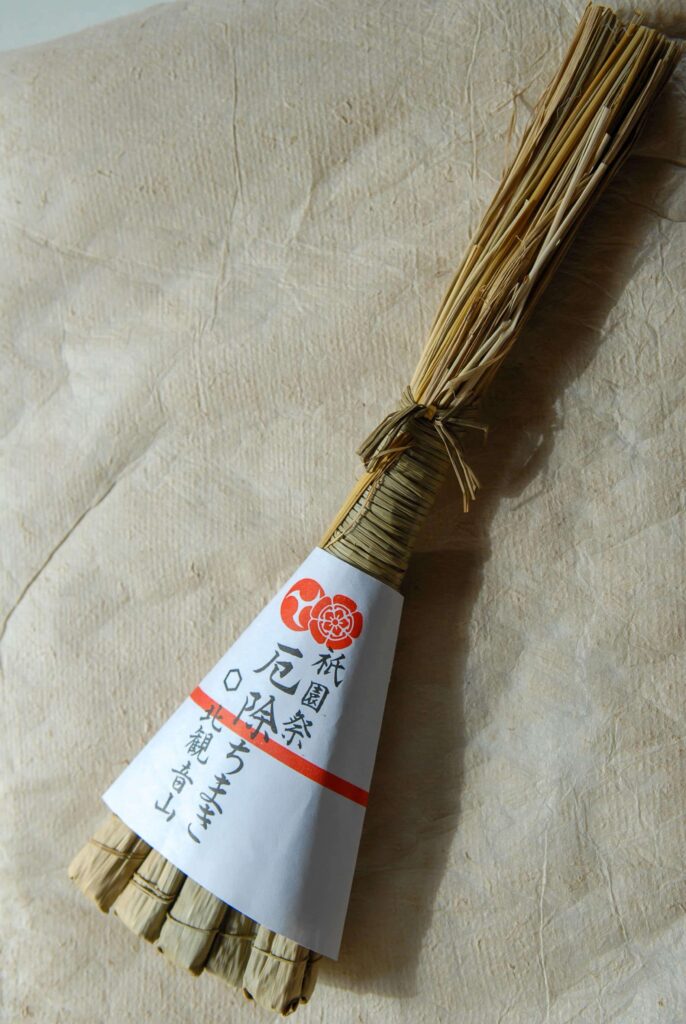
Chimaki Comeback
In 2019, the distinctive Gion Festival chimaki talisman sold out, and the small town in northern Kyoto that makes them was struggling to meet demand. When the Gion Festival floats weren’t built in 2020, this major form of economic support for both the Gion Festival floats and the town of producers suffered a major financial blow. Since fewer visitors were expected at Gion Matsuri 2022 compared to pre-covid, chimaki production was lower than 2019. But chimaki sales were again robust in 2022. Tsuki Boko, for example, sold out tens of thousands.
Chimaki are the clearest example of Gion Festival-dependent industries. But in truth many business—hotels and restaurants, for example, and traditional businesses like paper-lantern production, arts and crafts creation and preservation—rely on the Gion Matsuri taking place. Unfortunately, no monthly economic statistics were available from Kyoto City or the Kyoto Chamber of Commerce when I inquired in early 2022.
Making Use of Time Off from Covid
Some floats and their communities used the slow covid years very well. Kakkyo Yama, for example, refurbished their traditional kaisho building. In past years, its beautiful float treasures were exhibited in this traditional Kyoto townhouse space, similar to a single window-front. Unfortunately it was too small to allow satisfactory viewing by modern standards. (Historically, treasures were not on display to the public as much as they were available for locals and their guests to view privately. Also, it was a chance to air the items out, once a year.) This year Kakkyo Yama welcomed visitors to walk through its newly designed shrine space, its beautiful treasures easily visible for all to enjoy.
Meanwhile, significant parts of En no Gyoja Yama’s entire street block had been rebuilt or remodeled over the last few years. Though the charming traditional building En no Gyoja Yama’s treasures had been displayed in is gone, the chonai neighborhood community has displayed some forward thinking: some buildings were rebuilt or refurbished with traditional-looking facades. Meanwhile, the entire street is now lined with chochin lanterns and shimenawa, rope with white paper zig zags demarcating a sacred space in Japan’s indigenous Shinto spiritual tradition.
Visitors were surely less than in pre-covid years, but yoiyama, the Gion Matsuri’s huge street party on July 16, was still crowded, as were the floats and mikoshi processions on July 17 and 24. With so many people, social distancing was impossible. Japan’s excellent pro-mask culture provided some consolation, but did it provide us with protection?
Japan’s mask-wearing culture is universally embraced. Ofune Boko musicians before the July 24 Ato Matsuri procession.
Does the Gion Festival Fulfill Its Original Purpose?
As mentioned, the Gion Matsuri’s raison d’etre was to protect people from plagues common during Kyoto’s rainy season, or to get rid of them. This was of course before antibiotics and modern hygiene and sanitation.
Covid is an interesting phenomenon: a contemporary plague, persistent in spite of widespread vaccinations.
The Gion Matsuri communities were courageous to hold their festival while covid was not only persisting in Japan, but increasing: cases were on a steady rise since January 2022. In Kyoto, where the Gion Matsuri takes place, covid infections were at 36K on Jan 1, 2022, and at 213K on July 1, when the Gion Festival rituals begin. Covid-related deaths in Kyoto were at 292 on Jan. 1 and 747 on July 1. *
Known covid cases and covid-related deaths both have continued to rise all year, in Kyoto and throughout the country. With Gion Matsuri activities taking place throughout the month of July, documented covid infections in Kyoto went from 212,876 on July 1, to 293K on July 31 (and up to 530K on Dec 1). Meanwhile, covid deaths in Kyoto went from 747 on July 1, to 768 on July 31 (and up to 1,169 on Dec 1). *
Since antibiotics were introduced to Japan in the 1950s and before covid, the Gion Matsuri’s original plague-averting purpose graduallly took a back seat to tourism promotion. Covid has reinvigorated awareness of the festival’s origins. Some members of the Gion Matsuri community have been arguing since covid began that the festival should take place in its full form, so that it could serve its purpose.
It’s challenging to gauge: did the festival change anything related to the covid situation in Japan? Did it ever work against plagues? Does it hold importance beyond culture, history and tourism? If so, what?
Some international travelers are re-examining sacred travel destinations and experiences around the world for their contemporary relevance. What’s more, all the most loved travel destinations are struggling with issues around cultural sustainability, or how to meet the demand for the unique experiences that millions of visitors hope to have. Amidst these questions, Kyoto’s extraordinary Gion Matsuri provides a compelling case study.
* These statistics are thanks to this excellent covid-monitoring website.
Interested in sharing this content? Check out the Creative Commons Attribution-NonCommercial-ShareAlike 4.0 International License for guidelines on how. These guidelines provide an easy way to grow a culture of generosity, in line with the philosophy of sacred commerce.
